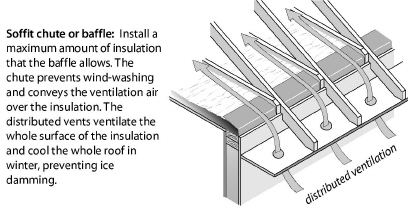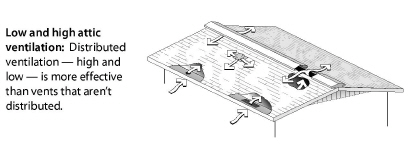
|
SWS Detail: 4.1088.1 Attic Ventilation, 4.1088.8 Installation/Correction of Unconditioned Attic Ventilation |
Attic ventilation has the following functions.
• To keep the attic insulation and the attic’s other building materials dry by circulating dry outdoor air through the attic.
• To prevent ice dams in cold weather by preventing snow melt by keeping the roof deck cold during the winter.
• To remove solar heat from the attic during the summer.
9.9.1 Attic Ventilation as a Solution for Moisture Problems
The best way to keep attic insulation dry is to air-seal the attic floor to block moist air from entering the attic. Adding attic vents may help to solve certain attic moisture problems.
• Seasonal moisture deposition removed by vents.
• Ice damming in areas that currently lack high and low vents.
Adding attic vents won’t solve these attic moisture problems.
• Moisture deposited by air leaks between the living space and the attic.
• Rain driven through attic vents.
• Roof leaks that dampen building materials beyond the capacity of the vents to dry.
9.9.2 When to Install Attic Ventilation
Install more attic ventilation only if you believe that the home needs one of the attic-ventilation functions listed above. Consider the following discussion points.
• Don’t increase attic ventilation without first sealing attic air leaks and testing the attic air barrier for adequate airtightness.
• Attic ventilation may not provide a useful function in some climates, such as persistently damp climates or windy, rainy climates.
Important note: An outright exception to ventilating attics is offered by the IRC if a code official determines that “atmospheric or climatic conditions” aren’t favorable to attic ventilation.
9.9.3 Attic Ventilation Requirements
Always vent exhaust fans directly to outdoors and never into a ventilated attic.
Net free area is the area of the vent minus the vent’s solid obstructions such as screens and louvers. The net free area is typically 50% to 70% of the gross vent area.
The IRC and SWS state these requirements for attic ventilation.
✓ Provide a maximum ratio of one square foot of net free vent area to 150 square feet of attic area.
✓ The IRC requires only one square foot of net free area per 300 square feet of attic area for cool-climate ceilings, that have an interior vapor barrier, or well distributed ventilation (high and low), or with thorough air-sealing of the ceiling.
✓ Vents must have screens, with 1/4-to-1/16 inch or less opening, to prevent the entry of pests and to reduce the entry of snow and rain.
✓ Vertical vents must have louvers to deflect rain.

✓ Install vent chutes or baffles to prevent blown insulation from entering the space between soffit vents and the attic. The baffles should allow the maximum amount of insulation to be installed over top plates without restricting ventilation paths. Vent chutes or baffles also help prevent the wind-washing of insulation caused by cold or hot air entering soffit vents. They should extend upwardly along the rafter to at least 4 inches above the finished insulation level.
✓ Don’t use powered ventilators to increase attic ventilation because of their energy consumption and doubtful effectiveness.
High and Low Vents
A combination of high and low vents is the best way to move ventilating air through the attic. Soffit vents and ridge vents are an ideal combination for high-low attic ventilation. However, gable vents and roof vents, located high or low, also create acceptable ventilation.

Power ventilators have limited value ventilating attics for air-conditioning energy savings or moisture mitigation.
• Power ventilators typically run longer than necessary.
• Power ventilators often consume more electricity than they save in reduced air conditioning.
• Power ventilators can pull conditioned air out through ceiling air leaks, counteracting their ventilating or cooling benefit.
According to the IRC, new attics may be unventilated if the two conditions listed here are both met.
1. There is no vapor barrier installed in the ceiling.
2. The roof assembly is insulated with an air-impermeable insulation, such as high-density sprayed polyurethane, to the bottom of the roof sheathing or foam board on the top side of the roof sheathing.